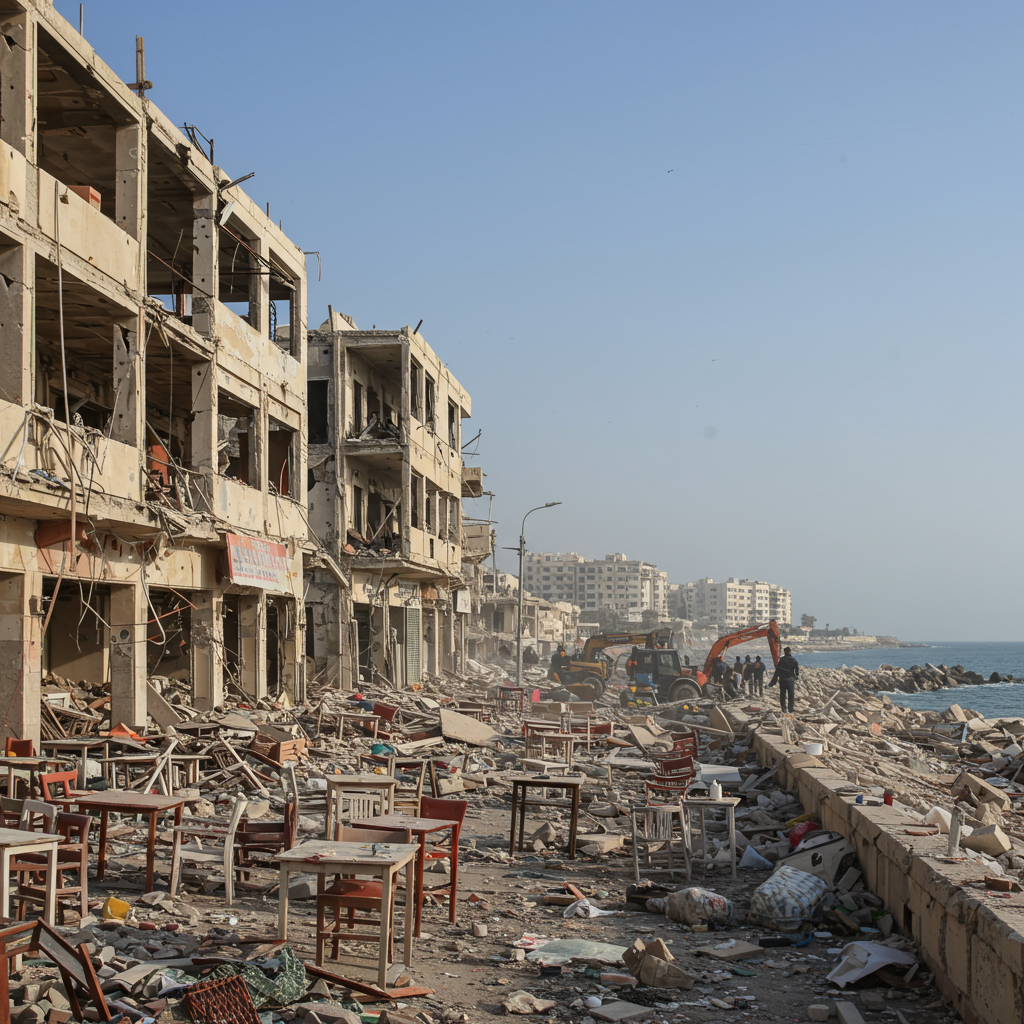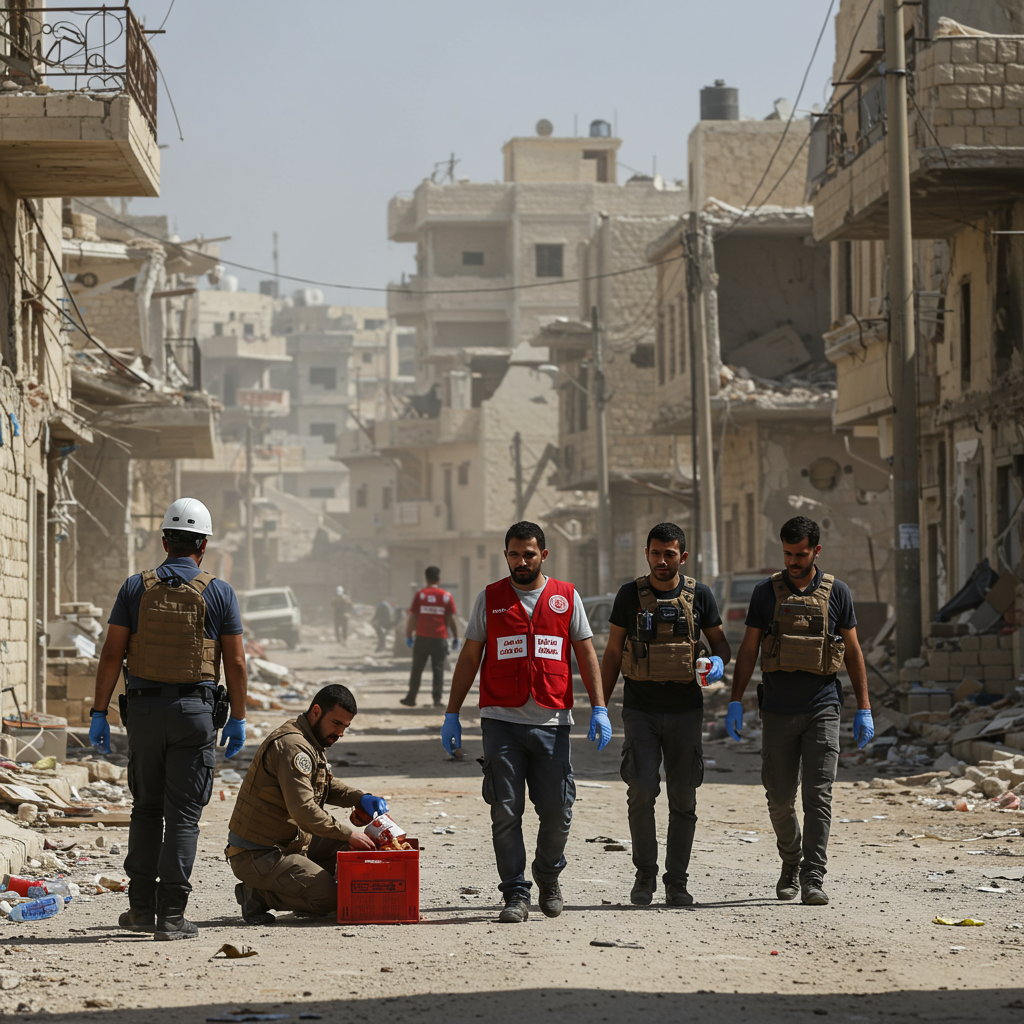A devastating Israeli strike on a crowded seaside cafe in Gaza City has left behind a scene of immense carnage, according to harrowing accounts from witnesses. The attack, which occurred Tuesday, resulted in at least 24 deaths and numerous injuries. What was moments before a busy spot for respite turned instantly into a site of horror and loss amidst the ongoing conflict in the territory.
The Attack Unfolds
The al-baqa cafe, situated near the harbor in Gaza City, was reportedly bustling in the early afternoon when it was struck by a missile. This single impact fundamentally transformed the atmosphere. A place that had offered a rare sense of calm within Gaza’s largest urban area was instantaneously converted into a scene of widespread destruction and death. The sheer force of the explosion was evident in the deep crater left behind, suggesting the use of a powerful weapon. Shattered concrete and roofing littered the area, mixed with tragic evidence of the human toll.
Victims and Their Stories
Among the many killed were women, children, and elderly individuals, highlighting the civilian impact of the strike. The casualties included notable figures within the community. Ismail Abu Hatab, a Palestinian photojournalist, lost his life in the attack. Frans al-Salmi, an artist known for his international exhibitions, was also confirmed among the deceased. The presence of families with young children at the cafe underscored its function as a community gathering spot, not solely a military target. The loss of cafe workers, all reported killed, further illustrates the strike’s devastating breadth.
Voices From the Scene
Survivors and those nearby described a grim aftermath. Abu al-Nour, 60, had just stepped out to grab lunch. As he returned, the missile hit. “Just as I was close, a missile struck,” he recounted. “Shrapnel flew everywhere.” The air filled with smoke and the sharp smell of gunpowder. Visibility dropped to near zero. He ran towards the cafe, finding it demolished. Inside, he saw bodies scattered across the ground. “All the cafe workers were killed,” he stated. He questioned the targeting of a place where families sought simple relief. “Why were they targeted?” he asked, noting it was a spot for people to escape the pressures of life.
Ahmad al-Nayrab, 26, was walking on the nearby beach when a loud explosion ripped through the air. “It was a massacre,” he told journalists. He described seeing “bits of bodies flying everywhere.” Bodies were mangled and burned. The scene was “bloodcurdling,” with screams echoing across the area. Ahmad highlighted the cafe’s popularity, mentioning it offered drinks, family spaces, and internet access. It was a known community hub.
Adam, 21, who worked renting chairs and tables nearby, also witnessed the event. When the strike happened, he immediately dropped to the ground as shrapnel rained down. He then joined rescue efforts. “When I reached the site, the scenes were beyond anything imaginable,” he said. He knew all the workers there personally. The cafe had been full of customers of “all ages,” he recalled.
Other witnesses painted a equally horrific picture. They reported seeing the body of a four-year-old child. An elderly man was observed with both legs severed. Numerous others suffered severe injuries, compounding the tragedy. Photographs taken at the scene depicted pools of blood and flesh amidst the debris, serving as stark visual evidence of the violence.
Broader Conflict Context
The Israeli military addressed the incident, stating on Tuesday it was reviewing the attack. The Israel Defense Forces (IDF) claimed the strike had targeted “several Hamas terrorists in the northern Gaza Strip.” An IDF spokesperson added that “prior to the strike, steps were taken to mitigate the risk of harming civilians using aerial surveillance.”
This strike occurred amidst a period of intensified Israeli military operations in Gaza. Recent days saw multiple waves of airstrikes across the territory. New “evacuation orders” have been issued, forcing tens of thousands more Palestinians to abandon makeshift homes, particularly across northern Gaza. These orders instruct people to move south into coastal zones. These areas are already severely overcrowded and lack adequate facilities or water supplies. Approximately 80% of Gaza is now either under such evacuation orders or controlled by Israeli forces.
The IDF has indicated its intention to advance into the center of Gaza City. This area is Gaza’s most densely populated region. The stated goal is to confront Hamas militants believed to be based there.
Recent reports highlight the widespread impact of the offensive. Al-Shifa hospital received casualties from two other recent strikes in Gaza City, reporting 15 deaths from those incidents. Witnesses, hospitals, and Gaza’s health ministry also reported that Israeli forces killed 11 people who were seeking food in the southern part of the territory, underscoring the dire humanitarian situation.
The War’s Toll
This latest event adds to the immense human cost of the ongoing Israel-Gaza war. The conflict began on October 7, 2023. On that day, Hamas-led militants launched attacks into southern Israel, resulting in approximately 1,200 deaths, primarily civilians, and the capture of around 250 hostages taken back to Gaza.
Israel’s subsequent military offensive has had devastating consequences for Gaza. More than 56,500 Palestinians have been killed, the majority of whom are civilians. The offensive has displaced almost the entirety of Gaza’s 2.3 million population. Much of the territory has been reduced to rubble by extensive bombardment and ground operations. The strike on Al-Baqa cafe stands as a stark, tragic example of the daily violence and its impact on civilians seeking moments of normalcy amidst unrelenting conflict.
Frequently Asked Questions
What happened at the Al-Baqa cafe in Gaza?
On Tuesday, a busy seaside cafe in Gaza City called Al-Baqa was hit by an Israeli missile strike. The attack instantly transformed the popular gathering spot into a scene of carnage. According to witnesses and initial reports, the strike killed at least 24 people and left many more injured. The cafe was reportedly crowded with customers of all ages at the time of the impact.
Who were the victims of the Al-Baqa cafe strike?
The casualties from the Al-Baqa cafe strike included a significant number of civilians. Women, children, and elderly people were among the minimum of 24 individuals killed. The dead also included specific community members, such as Palestinian photojournalist Ismail Abu Hatab and artist Frans al-Salmi. Witnesses reported seeing young children and cafe workers among the deceased, highlighting the non-military nature of many victims.
What was the context of the Israeli strike on the Al-Baqa cafe?
The strike on the Al-Baqa cafe occurred during a period of intensified Israeli military operations across the Gaza Strip. This offensive includes multiple airstrikes and new evacuation orders displacing tens of thousands. The IDF stated it was reviewing the attack and claimed it had targeted “several Hamas terrorists,” adding that steps were taken to mitigate civilian harm. The event takes place within the larger context of the Israel-Gaza war, which began in October 2023 and has resulted in extensive casualties, displacement, and destruction throughout Gaza.
Conclusion
The Israeli strike on Al-Baqa cafe serves as a grim reminder of the pervasive danger faced by civilians in Gaza. Witness accounts paint a horrific picture of sudden violence and mass casualties in a place meant for community and temporary relief. As the conflict continues and the Israeli offensive intensifies, events like the Al-Baqa cafe strike underscore the devastating human toll on the civilian population caught in the crossfire. The destruction of this popular gathering spot, and the lives lost there, represent another tragic chapter in the ongoing war.
Word Count Check: 930



